Cystotomies
What is a Cystotomy?
A cystotomy is a procedure where the surgeon enters the urinary bladder. The removal of uroliths is by far the most common reason for doing this surgery, however a cystotomy can also be performed to address bladder tumours (benign), ectopic ureters and bladder tears.
Situational Awareness
This is a commonly performed procedure to remove bladder stones in small animal practice. The procedure itself is not considered to be highly difficult and the bladder is an organ that heals well. The greatest challenge tends to be ensuring that all of the stones are removed from the bladder and the urethra (especially from the male dog and cat).
A commonly reported complication is the recurrence of uroliths after a cystotomy. A study published in 2010 showed that stones were incompletely removed at surgery in 42% of the patients (JAVMA 2010:237(7):763-766). This workshop provides the information needed to get that complication rate down!
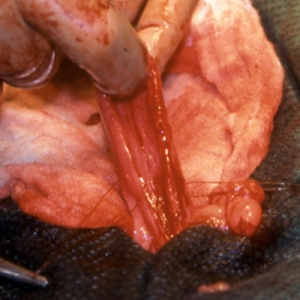
Get ready to Perform a Cystotomy:
All the information you need.
Fully narrated surgical videos.
In depth guide and more.
This content is designed for veterinary professionals. If you are a pet owner, please consult your vet if you have any questions about a surgery.
Pre-Surgical Considerations
- Take a radiograph of the abdomen which includes the entire lower urinary tract (avoid the catogram/dogogram).
- A urinalysis for evidence of infection and type of crystals present.
- Be prepared to harvest stones for analysis and mucosa for culture.
- Pre-operative radiograph includes bladder and the entire urethra. Try to position the limbs so that the fabellae are not confused with uroliths.
What the client needs to know:
- Dogs and cats with cystic calculi carry an excellent prognosis.
- The prevention of future stone formation will likely need to be addressed with proper dietary management.
Key points for a successful cystotomy

- Figure 1
Use stay sutures instead of tissue forceps to handle the bladder. This will minimize tissue trauma.
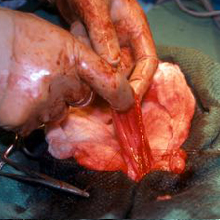
- Figure 2
Once you have created your ventral midline cystotomy incision, enlarge it to facilitate removal of the stones
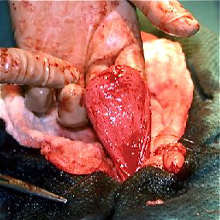
- Figure 3
Before closing, evert the bladder and look for tiny stones within the mucosa and flush.
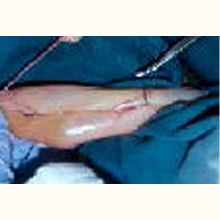
- Figure 4
I like the 2 layer closure in the dog because it is fast, has few knots and the inversion helps to prevent adherence of the bladder to the midline abdominal incision. Cats tend to have a thick small bladder which is harder to invert so I close in 1 layer with a simple interrupted pattern.
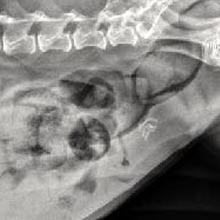
- Figure 5
Use a short lasting, preferably monofilament suture material for closing. Avoid PDS or other long lasting sutures as they can act as a nidus for stone formation as seen in the radiograph
Get ready to Perform a Cystotomy:
Instrumentation:
- Red Rubber catheter sterile, a large size is best (8-12Fr depending on the
size of the patient) - Saline and large syringe (20-60cc) for flushing
- Lap sponges
- Monofilament shorter lasting suture material is preferred (I use 3-0 in the
larger patient and 4-0 in the smaller ones). I like Monocryl™ , avoid using
PDS. - A spoon to scoop out the stones
Post-op expectations:
- Urine leakage is a rare issue in these patients.
- Healing time is relatively rapid and mostly attributable to the abdominal
incision. - The pet may have hematuria/pollakiruia for 0-3 days after surgery.
What you get when you register
- A thorough understanding of the anatomy from a surgical point of view.
- Step by step description of the surgery with narrated video including two
options for approaches in the male dog. - How to set up and position for the urethral flush and know that it is
thorough. - How to drape for the male dog
- How to get your biopsy
Price: $325 CAD
Q & A
How long is the recovery from a cystotomy?
Most pets will recover quite quickly from this surgery, however, it is an abdominal surgery. The abdominal incision should be allowed to heal properly. This usually takes about 2 weeks.
What happens after a cystotomy?
The pet may have blood in its urine for a few days after surgery and he/she may feel the need to urinate frequently in the first 24-48 hours after surgery, even though the bladder is empty. Many will show no signs of having any urinary issues after the surgery. The appropriate diet will be recommended once the type of stone has been determined.
Subscribe to our newsletter and receive 15% off a workshop of your choice!
Workshops & Courses
Blog
 The Secret to having the Bandage stay Above the StifleJuly 3, 2024 - 1:44 pm
The Secret to having the Bandage stay Above the StifleJuly 3, 2024 - 1:44 pm Common Mistakes made by Veterinarians when doing the Drawer TestJune 26, 2024 - 9:22 am
Common Mistakes made by Veterinarians when doing the Drawer TestJune 26, 2024 - 9:22 am Burying the end knot in a continuous subcutaneous suture patternJune 19, 2024 - 7:35 pm
Burying the end knot in a continuous subcutaneous suture patternJune 19, 2024 - 7:35 pm Creating Donuts for your BandagesJune 12, 2024 - 3:15 pm
Creating Donuts for your BandagesJune 12, 2024 - 3:15 pm The Knotless Suture PatternJune 5, 2024 - 2:45 pm
The Knotless Suture PatternJune 5, 2024 - 2:45 pm

